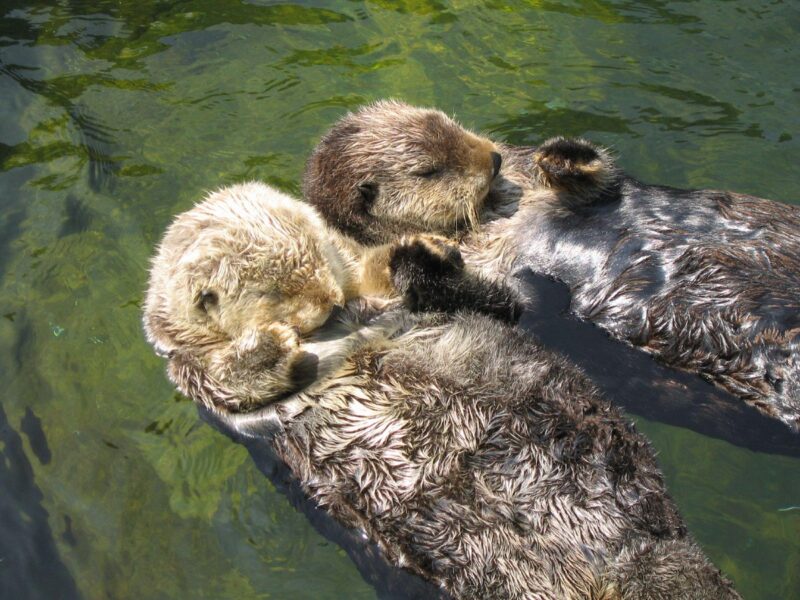The image of otters holding hands has captured the hearts of people around the world, transcending its biological purpose to become a symbol of love and companionship.
They Are Social Creatures
Otters are known for their strong social bonds, particularly among sea otters. These marine mammals display a variety of social behaviors, with hand-holding being one of the most notable.
This behavior, scientifically known as ‘rafting,’ typically occurs when they are resting. They join hands with each other to form a group, known as a raft, which can comprise just a few otters or up to hundreds in some cases.
Bonding and Social Structure
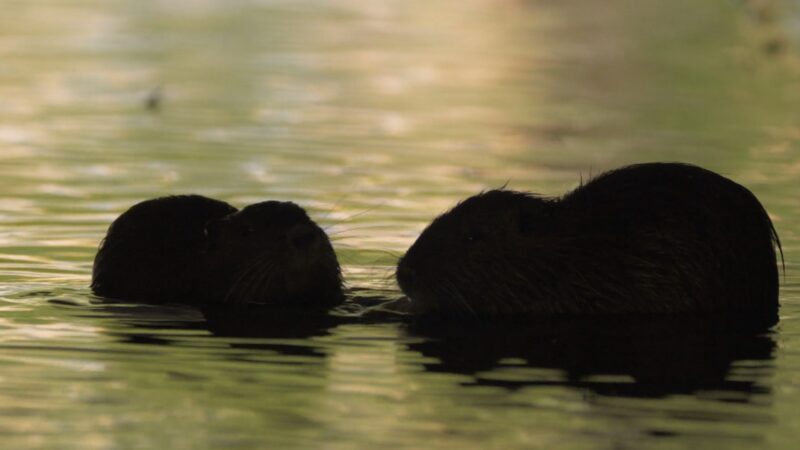
The social structure is intricate and plays a significant role in their survival. In sea otters, females and pups often form their own groups, separate from male groups. This segregation is crucial for their survival and breeding strategies.
In the vast and often unpredictable ocean environment, staying connected is crucial. By holding hands, they can keep their group intact, which is essential for mutual protection and assistance. This behavior is particularly important during resting periods, when otters are most vulnerable to predators and environmental hazards.
Communication and Interaction
Communication involves a complex mix of vocalizations, body postures, and scent markings. However, the physical act of holding hands is a significant aspect of their social interaction. It’s a way for otters to stay connected in their watery environment, where currents and waves can easily separate them.
They also use hand-holding as a way to communicate during play. Young otters, in particular, engage in various playful activities, which are crucial for their development and learning. Through these playful interactions, they learn essential survival skills such as hunting and escaping predators. Hand-holding during play strengthens social bonds and enhances communication skills, preparing them for adult life.
It is a Way of Adaptation
The behavior of holding hands is not just a social activity; it’s a critical survival adaptation. In the ever-changing and often harsh marine environment, staying together is not just about social bonding but also about survival.
Protection from Drifting Apart
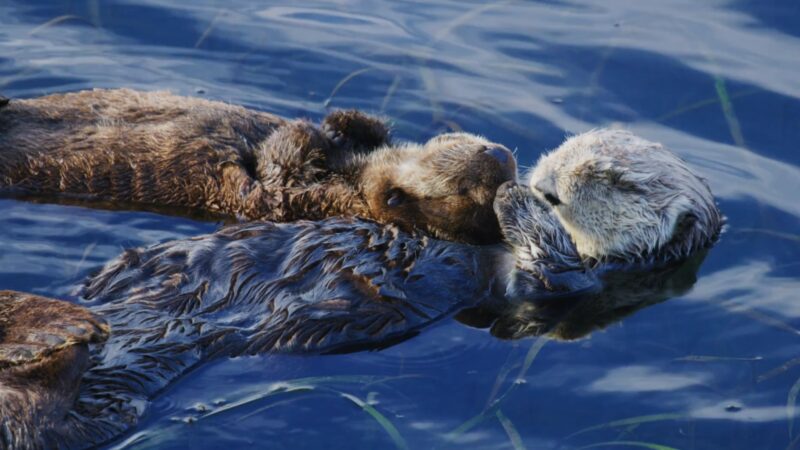
One of the primary reasons is to prevent drifting apart while they sleep. The ocean is a dynamic environment, with currents and tides constantly in motion. By holding hands, these charming animals form a connected group, or raft, which helps them stay together.
However, when they are in a group, their combined vigilance and defensive actions can deter potential threats. The hand-holding behavior, therefore, is a strategic adaptation that enhances their survival in the open sea.
Challenging Environmental Conditions
Hand-holding is also an adaptation to their specific environmental conditions. Sea otters, for instance, inhabit coastal waters where temperature fluctuations can be significant.
Instead, they rely on their dense fur and group behaviors like hand-holding to maintain body heat. This adaptation is particularly important in colder waters, where maintaining body temperature is vital for survival.
It is Important Part of Their Evolution
The hand-holding behavior of otters, while serving immediate survival and social needs, also offers insights into their evolutionary journey.
Evolution of Social Behaviors
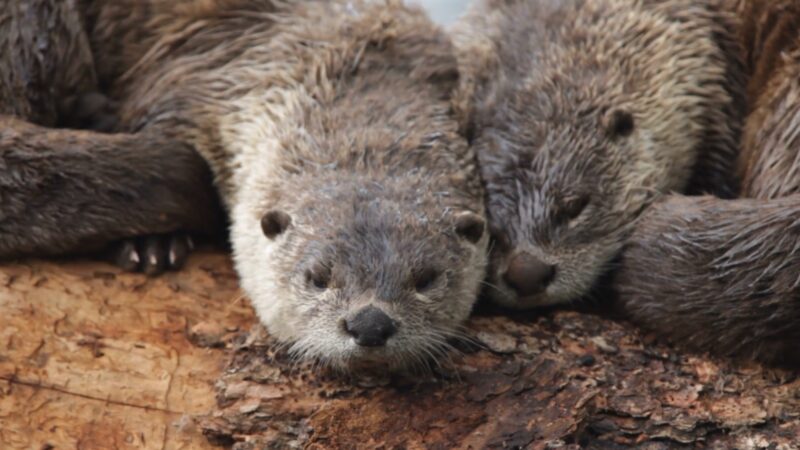
Otters belong to the Mustelidae family, which includes animals like weasels, badgers, and ferrets. Among this family, otters are unique for their highly developed social behaviors, particularly in sea otters.
This high parental investment might have driven the evolution of stronger social bonds and behaviors like hand-holding, ensuring the safety and survival of the young in a challenging environment.
Sign of Adaptability
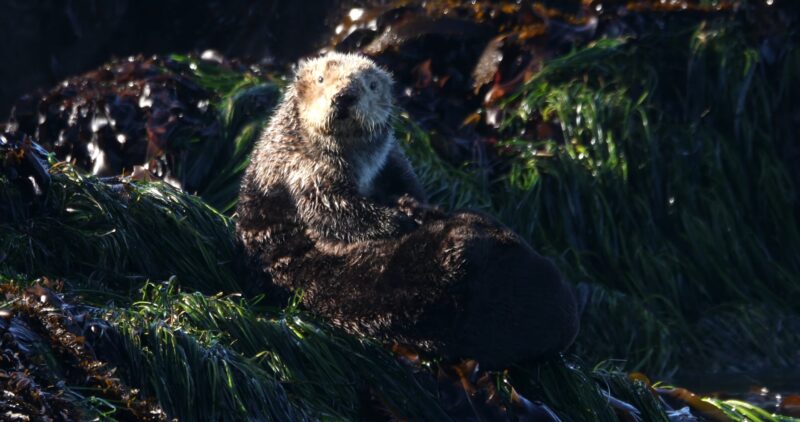
Hand-holding is not just a result of their evolutionary past; it also demonstrates their adaptability. Otters have shown remarkable resilience in the face of environmental changes and human impacts. Their ability to modify behaviors, like hand-holding, in response to changing conditions is a testament to their adaptability.
The adaptability, as seen in their hand-holding behavior, is crucial for their survival in a rapidly changing world. It highlights their capacity to respond to environmental pressures, whether natural or anthropogenic. This adaptability will be key in facing future challenges, particularly in the context of climate change and habitat loss.
FAQs
What is the reason behind otters carrying rocks?
Otters use rocks as tools to break open shellfish, showcasing their unique ability among mammals to use tools.
How do otters typically react to human presence?
Otters may seem friendly, but as wild animals, their behavior can be unpredictable, and it’s safest to observe them from a distance.
What does hugging signify in otter behavior?
Hugging among otters is a social activity that strengthens bonds and provides comfort, commonly seen between mothers and their young.
What is the purpose of otters touching noses with each other?
Nose touching is a communicative gesture among otters, used for greeting and establishing social connections.
Is it safe for humans to touch otters?
Touching otters is not recommended, as it can lead to unpredictable reactions from the animals and disrupt their natural behaviors and habitats.
Last Words
The human fascination with otter hand-holding goes beyond mere admiration; it has cultural significance and plays a role in conservation efforts. This behavior, while serving essential functions for otters, has also become a symbol of connection and unity for people. It highlights the power of wildlife to inspire and engage the public in conservation and environmental stewardship.
Related Posts:
- Why Do Dolphins Jump Out of the Water? - Unique and…
- Why Do Frogs Scream? Are these or Help or Something More?
- Characteristics Of North American Bears - A…
- 9 Deserts in Africa: Pics, Maps, Interesting Facts & More
- How Long Can a Hydro Flask Be Used For? Maintenance…
- Why Do Foxes Scream at Night? Vocal Enigmas of the Night


